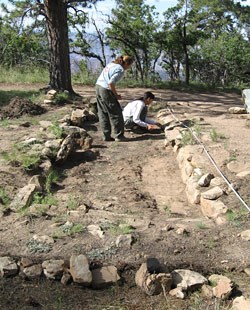
NPS PHOTO In late June 2008, archeologists from Grand Canyon National Park’s Division of Science and Resource Management cleaned and stabilized Transept Ruin, a two-room ancestral Puebloan (Anasazi) ruin on the North Rim. The work was undertaken as part of the Vanishing Treasures program, which is the National Park Service’s ruin preservation program. Transept Ruin is located along the Transept Trail between the Lodge and the North Rim Campground. The archeological site consists of the remains of a two-room house, or pueblo, that was most likely occupied seasonally by a farming family approximately 900 years ago. The residents of this pueblo probably used a nearby spring and the open parkland in the ponderosa pine forest near the site during the summer and fall growing season. Today, all that remains of the masonry house are upright slab footing stones, one or two courses of masonry, and the floor surface. National Park Services archeologists first recorded the site in 1936, and it was excavated in 1969. Unfortunately, the site wasn’t stabilized after excavation. Since 1969, it has deteriorated significantly because of natural erosion and impacts caused by visitation. People have impacted the site by stepping on, and stacking rocks on top of, the stone masonry walls. In 2007, archeologists assessed the site by examining historic photographs, field notes, and site descriptions, and by comparing them to the site’s current condition. The study concluded that the site still had integrity for public interpretation but needed to be stabilized to improve its poor condition. During the week of June 23-27, 2008, Grand Canyon National Park archeologists Ian Hough, Ellen Brennan, and Margi Shaw cleaned and stabilized Transept Ruin. The preservation crew’s objective was to partially backfill the interior of the rooms in order to improve the structure’s condition while still allowing for public interpretation and viewing of the site. The backfill material will help hold the masonry walls in place and will slow structural deterioration, while keeping the upper edges of the walls exposed and visible. First, the archeological crew cleared the site of organic debris, removed grasses and shrubs from the interior of the rooms, and removed stones from the tops of the walls that had been added by visitors over the years. Once the lower wall faces were exposed, the crew carefully documented the spatial alignment of the two rooms and the walls and other attributes of the structure, including the types of stone and mortar used during construction. 
The crew reset stones that had fallen from the walls or were partially collapsed, then used 200 cubic feet of sterile soil and rock rubble to fill the interior of the rooms, leaving only the uppermost surface of the wall tops exposed. The grasses and shrubs that had been removed from the structure’s interior at the start of the stabilization work were replanted on the outside of structure to help naturalize the site. After stabilization work, the site looked like an unexcavated structure in a natural state of preservation similar to many other small ruins on the North Rim, such as those in the Widfross area. While room size, layout and outline are still clearly visible in Transept Ruin, partially backfilling the site protects it from further deterioration. During their work, the archeological crew also made a number of small but important discoveries at Transept Ruin. They documented aspects of the masonry construction that had not been recorded during the 1969 excavation effort and recorded the presence of a small spring below the site that was likely used by the pueblo’s original occupants. The Vanishing Treasures program protects prehistoric and historic architectural sites in park service areas in the arid West. Vanishing Treasures archeologist Ellen Brennan explained, “These sites are important links to the past for traditionally-associated Native American tribal members and for the American people. Transept ruin is one of many Vanishing Treasures sites in Grand Canyon National Park. By maintaining the site, we hope to give visitors a better understanding of the ancestral Puebloan culture, archeological investigations, and the continuing importance of the Grand Canyon to Native American people.” |
Last updated: October 25, 2022
